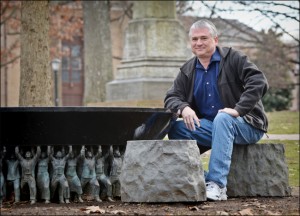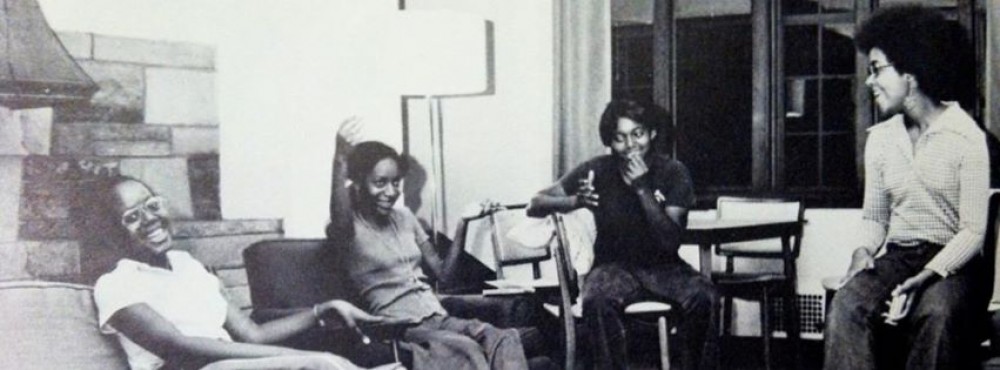by Emma Kioko

Dr. Tim McMillan, developer of UNC’s Black and Blue Tour, via Virtual Black and Blue Tour website.
Last week, Grace and I had the opportunity to speak with Dr. Tim McMillan about our project. As the creator of and researcher for the Black and Blue tour at the University of North Carolina at Chapel Hill, Dr. McMillan was an invaluable source of inspiration and information. During our conversation, Dr. McMillan talked a lot about institutional erasure. It is in the best interest of elite academic institutions, he argued, to erase, obscure, or trivialize discourses and histories of racism and racial intolerance on administrative, social, and academic levels. This erasure, whether or not it is intentional, makes projects such as ours incredibly important.
Visit: Virtual Black and Blue Tour at UNC
One of the most important components of both our walking tour and digital record will be the histories we rediscover, re-remember, and represent to the Bryn Mawr community and beyond. With that in mind, I wanted to share a little bit more about how this project came to fruition as both a Praxis independent study course and potential walking tour.
When I encountered the Black and Blue tour as part of my summer research at UNC, I immediately thought about Bryn Mawr. While UNC’s history is much different from ours (owing to a history that is deeply rooted in slavery), I was incredibly struck by the similarities I noticed between the large southern research university and our small northern liberal arts college. After taking the tour, I sent a page-long email to the Pensby Center, our campus diversity office, about my experience. On my mind at the time was the potential for a translation of the UNC tour to create conversation about spaces on campus that are unknowingly fraught with racial tension on Bryn Mawr’s campus. I wrote:
“Professor McMillan took us on a brilliant and moving historical tour of the campus that addressed UNC’s interactions with black people dating all the way back to slavery. Because UNC’s history is deeply entrenched with slavery, they have wounds surrounding on-campus campus race-relations that run deep. However Professor McMillan’s tour not only drew out the individual stories of black people on UNC’s campus that have been negative or forgotten, he also brought their legacies in graceful conversation with the campus today. While the tour began at the landmark statue of ‘The Civil War Soldier,’ an imposing piece facing fearlessly towards the North, he ended with a discussion of black people on UNC’s campus such as Zora Neale Hurston who fought tirelessly and refused to let racist attitudes dictate their experiences, ultimately creating the UNC that stands today.
… I was thinking of doing some research in special collections this fall to see if I could orchestrate a similar tour on Bryn Mawr’s campus. The Black and Blue tour really resonated with me for the reason that it allowed me to both understand some of the harsher realities of UNC’s past as an academic institution, but also made me proud of just how far it has come since — I can only imagine how powerful this could be at Bryn Mawr.”
At the end of the letter I asked for the Pensby Center to give me guidance on next steps: what people on campus I should contact, what resources I should tap into, etc. A few days later, I received a one line reply that noncommittally suggested a meeting in the Fall. I found myself discouraged. I didn’t think that the intent of the Pensby Center’s reply was to brush me off, but I felt as if my idea was trivialized. Without knowledge of the resources I would need to complete the project and uncertainty about the support I would receive, I didn’t follow through with the idea at the end of the summer break.
This project has already been a tremendous undertaking, we are only halfway through the Spring semester and so many people have been imperative to the continuation and creation of the project. There are many processes and details that I most likely would not have had access to as just one undergraduate student. If it hadn’t been for the now infamous “Confederate flag” incident on campus, this project would most likely never materialized — the idea would have been long lost in a short email exchange in-between academic terms. After the incident on campus and the reactions among the college community, I once again thought about my idea for a tour — this time I knew I had to market my idea to the right audience. The tour is first and foremost an opportunity for the re-remembering of lost histories and a potential space for reflection among the campus community. After the events on campus, I reached out to President Cassidy with the idea. After receiving an almost instantaneous email of tremendous support, I was able to forward her email and my idea to faculty and staff members who took the idea seriously. Within a week, we had arranged a meeting among a number of our community members. Out of this experience, I learned just how difficult it can be to find agency for these forgotten histories. It is too easy to only focus on these histories in times of institutional and social distress.
When speaking with Dr. McMillan about institutional erasure, I realized just how easily the experiences of people of color can be forgotten and erased. It is important we don’t forget these histories when it is convenient. While this project officially comes out of an experience of racial tension on campus, it is my hope that the conversations about and re-rememberings of these histories can continue well beyond this semester of reflection. Black voices, particularly black women’s at elite institutions voices, deserve to be heard and remembered. It might be difficult and painful, but it is important. Already this experience is helping me find a voice for my experiences, and it is my hope to rediscover many others’ voices and experiences that have been silenced or lost over time.

Pingback: Emma’s Reflections: Speaking, Questioning, Moving Forward | Black at Bryn Mawr
Pingback: Early Bryn Mawr Black History, 1719-1824 | Black at Bryn Mawr